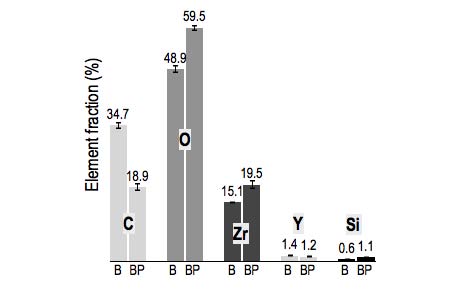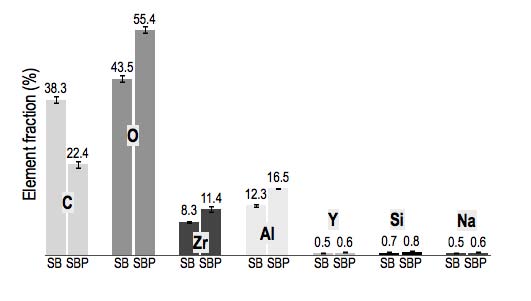Surface chemistry and bond strength to Y-TZP after Plasma treatment
Valverde GB, Coelho PG, Carvalho RM, Jamal M, Thompson VP, Lorenzoni FC, Delben J, Silva NRFA
Objective: To chemically characterize and test bond strength (MTBS) of Y-TZP surfaces after Atmospheric Pressure Plasma (APP) application combined with different surface conditioning methods. Methods: Y-TZP discs (13.5 mm X 4mm) were obtained from the manufacturer and composite resin (Z-100) discs with similar dimensions were prepared. All discs were polished to 600 grit and divided into 8 groups (n=3 discs each), four controls (Non-APP treated) and four experimental (APP treated) groups. All groups received one of the following treatments: sand-blasting (SB group), Clearfil ceramic primer application (MDP group), sand-blasting + MDP application (SBMDP group), or no treatment (B group). The experimental groups were APP treated for 10 s. Surface energy (SE) and X-ray photoelectron spectroscopy (XPS) readings of polished and sandblasted Y-TZP were evaluated. Y-TZP and Z-100 discs were bonded with Rely X Unicem cement and cross-sectioned to form beams. Half of the beams were kept dry and half were aged. Microtensile bond strength (MTBS) test was performed. Statistical analyses comprised of one-way ANOVA and Tukey at 95% for SE and a three way mixed model ANOVA at a 95% for the MTBS. Results: SB and B groups showed high SE levels after APP treatment. An increase in O and decrease in C elements was detected in the APP-treated discs (Figure 1). All APP groups tested dry showed higher bond strength (p<.05) than the untreated counterparts. Bond strength was partially affected by the aging process.
Fig 1: XPS of Y-TZP. a: polished and b: sand-blasted
Conclusion: APP application greatly increased bond strength (p<.05) when it was applied alone or in combination with treatments designed to improve bond strength to Y-TZP in dry conditions.
Keywords: Adhesion, Atmospheric Plasma, Ceramics, Prosthodontics and Surfaces
See more of: Dental Materials 1: Adhesion - Bond Strength Testing and Mechanisms
![[ Visit AADR's Website ]](images/banner.jpg)

